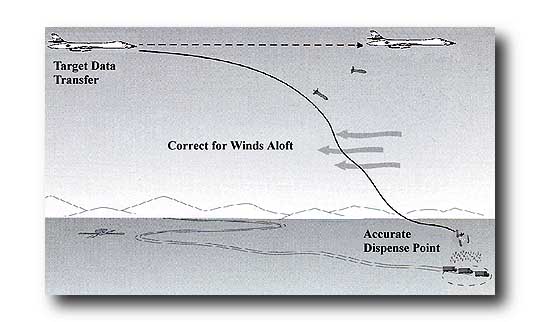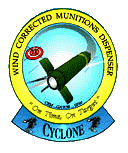




 While low altitude, high speed laydown deliveries are consistent with tactics used against heavily defended target sets such as the robust Soviet/Warsaw Pact threat envisioned in Central Europe, low altitude tactics were not the preferred option during Desert Storm where the USAF used medium/high altitude weapons employment to provide fighter and bomber aircraft a sanctuary against short range surface to air missiles and anti-aircraft artillery fire. The inexpensive tail kit inertially steers the munition from a known release point to precise target coordinates while compensating for launch transients, winds aloft, surface winds and adverse weather.
While low altitude, high speed laydown deliveries are consistent with tactics used against heavily defended target sets such as the robust Soviet/Warsaw Pact threat envisioned in Central Europe, low altitude tactics were not the preferred option during Desert Storm where the USAF used medium/high altitude weapons employment to provide fighter and bomber aircraft a sanctuary against short range surface to air missiles and anti-aircraft artillery fire. The inexpensive tail kit inertially steers the munition from a known release point to precise target coordinates while compensating for launch transients, winds aloft, surface winds and adverse weather.
The Wind Compensated Munitions Dispenser [WCMD "Wick-Mid"] is intended to remedy this current shortfall in Tactical Munition Dispenser munitions, such as the CBU-87 CEM [Combined Effects Munition], CBU-89 GATOR and CBU-97 SFW [Sensor Fuzed Weapon]. The weapon will use inertial guidance only (no GPS). The WCMD program develops a tail kit for these inventory dispenser weapons. These weapons will be capable of delivery from medium to high altitude delivery when equipped with a WCMD kit. The WCMD weapon will correct for wind effects and errors during the weapon's ballistic fall. The WCMD kit will turn these "dumb" bombs into accurate "smart" weapons. Currently, the dispenser is achieving an accuracy of within 30 feet. Both fighter and bomber aircraft will be able to employ WCMD from a wide range of altitudes, in adverse weather, using various tactics such as level, dive, and toss bombing, and bombing on coordinates.
WCMD Limited Initial Operational Capability was achieved on the B-52 in November 1998. WCMD-equipped weapons are planned for employment on the B-1, B-52, F-15E, F-16, and F-117 aircraft.
The WCMD is seen as one solution to four deficiencies identified in the Strategic Attack/Air Interdiction Mission Area Plan (MAP): multiple kills per pass, adverse weather capability, Cluster Bomb accuracy (mid-course wind correction), and the ability to carry/dispense future submunitions and US Army mines. With the addition of a guidance kit and "smart" aircraft stores stations, aircrew members should be able to independently target weapons and strike multiple targets on a single release/pass. WCMD will be targetable by on-board aircraft systems and be capable of being targeted on a coordinate reference system. To minimize aircraft heading, velocity, and position errors, all aircraft will have Global Positioning System (GPS) quality heading, velocity, and altitude data. This will provide aircraft an adverse weather capability for targets with known positions. GPS is not required on the WCMD. The guidance kit will provide WCMD an adverse weather capability and negate a need for electro-optical guidance systems which are severely degraded by adverse weather or man-made or battlefield obscurants such as smoke or dust. The WCMD kit will reduce susceptibility to wind induced errors, not fully compensated for by aircraft avionics, by providing mid-course wind correction. Finally, the modular design of the SUU-64/65/66 Tactical Munition Dispensers (TMD) allows for future incorporation of wide area anti-armor mines, anti-helicopter mines, and other future smart submunitions.The Air Force announced 27 January 1997 that Lockheed Martin had won the $21 million contract to complete development and begin production of the Wind-Corrected Munition Dispenser. The Air Force plans to modify 40,000 tactical munitions dispensers.
Department of Defense officials originally predicted the dispenser tail kits would cost approximately $25,000 per unit. However, through the application of a no-nonsense acquisition strategy adopted by the Eglin WCMD team, the dispenser unit cost is $8,937.

